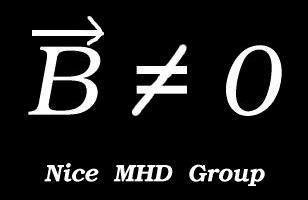
|
UK MHD Meeting 2004
Thursday 6th and Friday 7th May 2004
Nice - Cote D'Azur
Laboratory Cassiopée UMR6202 CNRS
Observatory of the Cote d'Azur
|
  |
Magnetic field
dissipation during the solar flare 23rd July 2002
Valentina Zharkova
,
Bradford University
We analyze the SOHO/MDI high-cadence
magnetic field variations occurring prior and during the 2002 July 23
flare $2B/X4.8$
and their association with the hard X-ray and
$H_{\alpha}$ emission observed with RHESSI and BBSO. The line-of-sight
(LOS)
magnetic field variations associated with the flare
23 July 2002 occurred in a bipolar area around the magnetic inversion
line,
or apparent neutral line (ANL), located with the
automated morphological edge detection technique.
There were 4 hard X-ray sources observed by RHESSI
payload in different
energy bands, three of them were associated with
magnetic field changes. In the hard X-ray footpoints
located on the south-east of the ANL with the strongest negative LOS
magnetic
field and north-west from the ANL with positive
polarity, the irreversible descrease of magnetic field (or increase in
absolute value)
was measured starting 2 minutes prior the flare,
decreasing by 120 G and staying at this level after the flare offset.
The magnetic field changes in the whole area were
irreversible showing an increase of magnetic flux from $6.7\times
10^{21}$ Mx
up to $7.9\times10^{21}$ Mx lasting for 6 minutes
until 00:30:00 UT when the magnetic field returned to noise
fluctuations
about the new magnitude. Before the flare occurrence
there were 9 pre-existing sources of a strong
magnetic field of the positive and negative
polarities about 400-600 G and 6 new emerging sources: 2 negative of
-580 G and
-380 G and 4 positive of 100-160 G which were found
to be associated with the 3 hard X-ray footpoints. The emerging
negative
sources appeared in a close location and at the time
when the ANL was moved towards the positive polarity with
a speed of 250 km/s. Based on the global magnetic
reconnection models, the rates of magnetic field changes
(a reconnection rate) deduced from the total area
around the ANL and
from the area of the hard X-ray footpoint with
irreversible changes were found to be about $3.1\times10^{18}$ Mx/s,
the average Poynting flux was$5\cdot 10^{11}$
$erg/cm^2/s$. This resulted in the magnetic energy of
$\sim 1.2\times 10^{31}$ erg released during this
flare in one magnetic source associated with the hard X-ray
footpoint, which can be increased to $\sim 2.3\cdot
10^{31}$ erg, if the other two footpoints are taken into
account.





